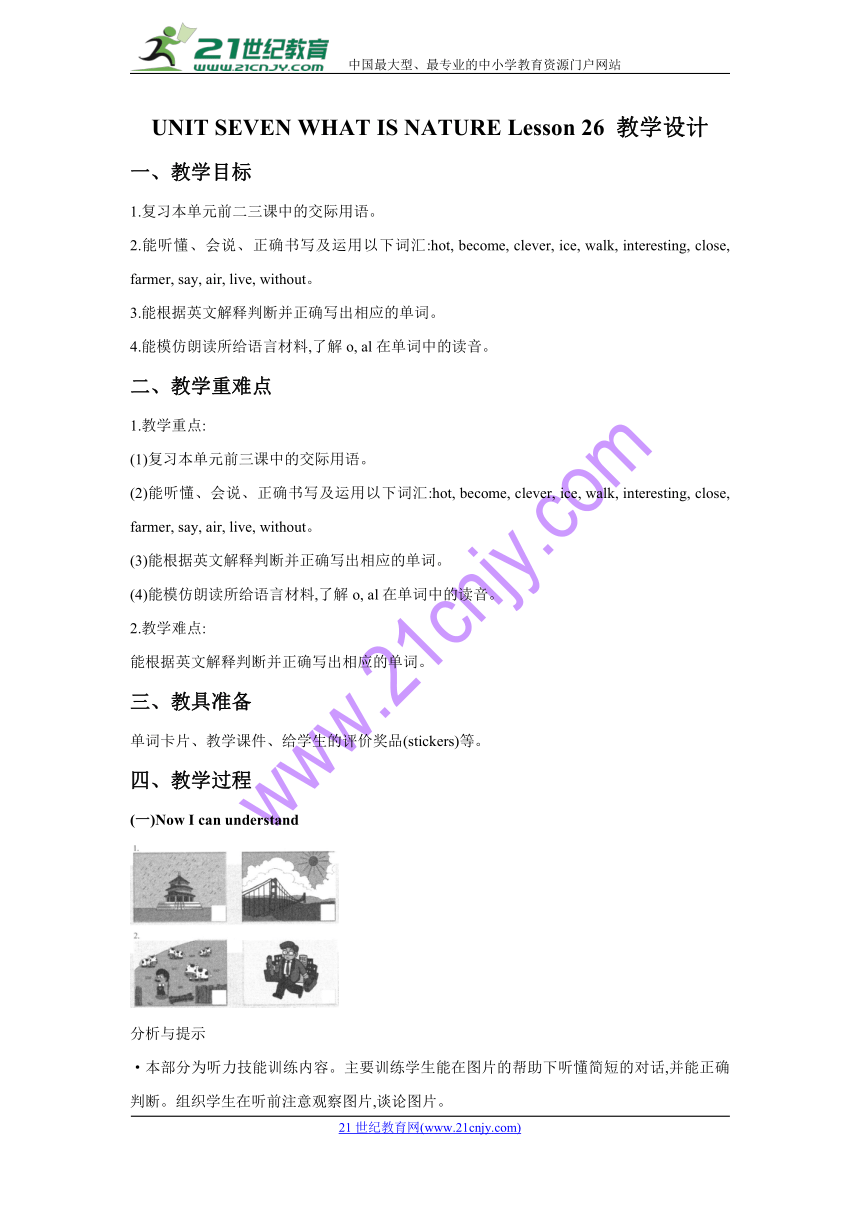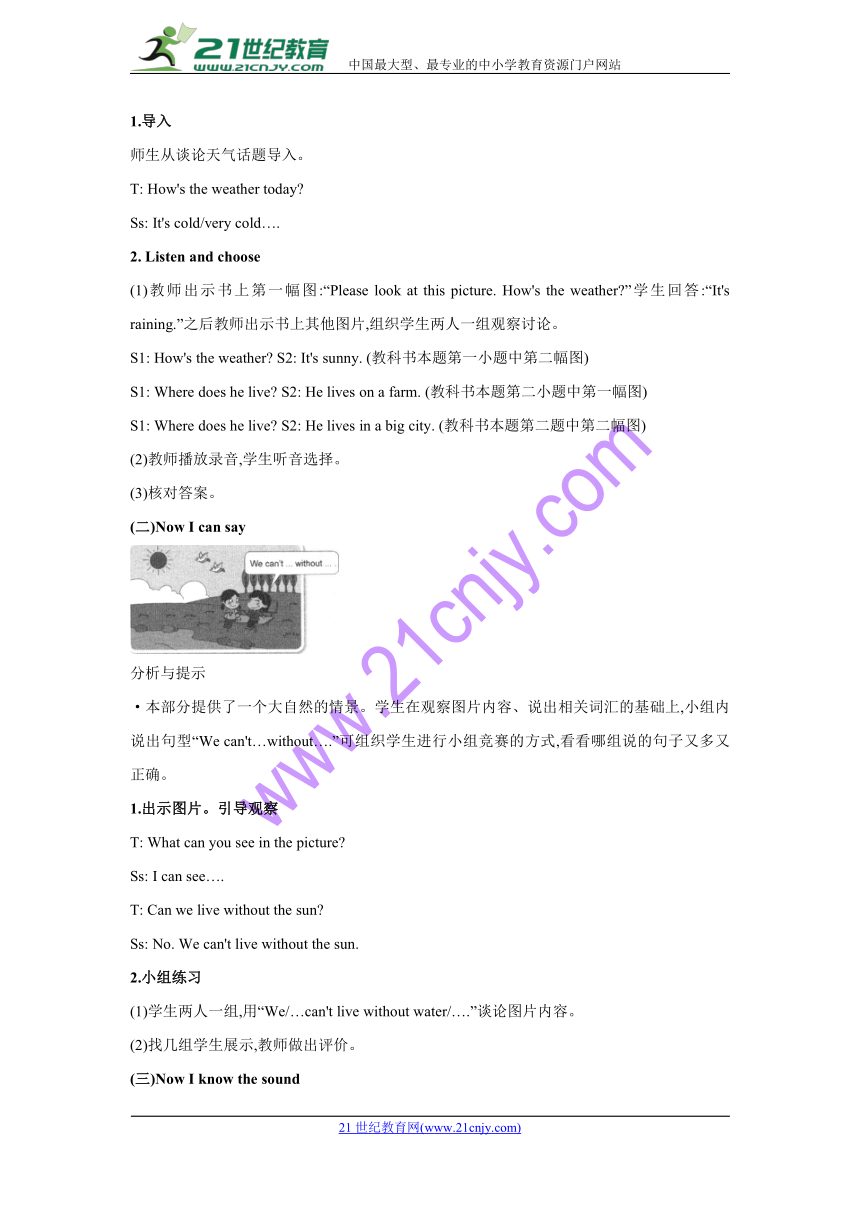Unit 7 What is nature Lesson 26 教学设计
文档属性
| 名称 | Unit 7 What is nature Lesson 26 教学设计 |  | |
| 格式 | zip | ||
| 文件大小 | 261.3KB | ||
| 资源类型 | 教案 | ||
| 版本资源 | 北京版 | ||
| 科目 | 英语 | ||
| 更新时间 | 2018-06-11 22:32:29 | ||
图片预览


文档简介
UNIT SEVEN WHAT IS NATURE Lesson 26 教学设计
一、教学目标
1.复习本单元前二三课中的交际用语。
2.能听懂、会说、正确书写及运用以下词汇:hot, become, clever, ice, walk, interesting, close, farmer, say, air, live, without。21教育网
3.能根据英文解释判断并正确写出相应的单词。
4.能模仿朗读所给语言材料,了解o, al在单词中的读音。
二、教学重难点
1.教学重点:
(1)复习本单元前三课中的交际用语。
(2)能听懂、会说、正确书写及运用以下词汇:hot, become, clever, ice, walk, interesting, close, farmer, say, air, live, without。21·cn·jy·com
(3)能根据英文解释判断并正确写出相应的单词。
(4)能模仿朗读所给语言材料,了解o, al在单词中的读音。
2.教学难点:
能根据英文解释判断并正确写出相应的单词。
三、教具准备
单词卡片、教学课件、给学生的评价奖品(stickers)等。
四、教学过程
(一)Now I can understand
分析与提示
·本部分为听力技能训练内容。主要训练学生能在图片的帮助下听懂简短的对话,并能正确判断。组织学生在听前注意观察图片,谈论图片。21世纪教育网
1.导入
师生从谈论天气话题导入。
T: How's the weather today?
Ss: It's cold/very cold….
2. Listen and choose
(1)教师出示书上第一幅图:“Please look at this picture. How's the weather?”学生回答:“It's raining.”之后教师出示书上其他图片,组织学生两人一组观察讨论。21cnjy.com
S1: How's the weather? S2: It's sunny. (教科书本题第一小题中第二幅图)
S1: Where does he live? S2: He lives on a farm. (教科书本题第二小题中第一幅图)
S1: Where does he live? S2: He lives in a big city. (教科书本题第二题中第二幅图)
(2)教师播放录音,学生听音选择。
(3)核对答案。
(二)Now I can say
分析与提示
·本部分提供了一个大自然的情景。学生在观察图片内容、说出相关词汇的基础上,小组内说出句型“We can't…without….”可组织学生进行小组竞赛的方式,看看哪组说的句子又多又正确。2·1·c·n·j·y
1.出示图片。引导观察
T: What can you see in the picture?
Ss: I can see….
T: Can we live without the sun?
Ss: No. We can't live without the sun.
2.小组练习
(1)学生两人一组,用“We/…can't live without water/….”谈论图片内容。
(2)找几组学生展示,教师做出评价。
(三)Now I know the sound
分析与提示
·本部分内容为语音的学习与归纳。主要是字母o, al的发音对比。教师让学生观察老师的口型,体会/?/和/?:/的发音。www.21-cn-jy.com
(1)教师PPT出示单词ox, shop, lock, dog让学生读出它们的读音,之后总结字母o发音/?/,教师示范口型。【21·世纪·教育·网】
(2)教师PPT出示单词tall, ball, all让学生读出它们的读音,之后总结字母al发音/?:/,教师示范口型。21·世纪*教育网
(3)教师播放录音,学生跟读。
(4)教师播放韵文录音,学生跟读、体会字母o, al在单词中的发音。
(5)学生两人小组练习朗读韵文。
(6)教师找1~2组学生展示,教师做出评价。
(四)Now I can read
Everything around us is nature: air, water, trees, lake, and hills. We cannot live without water. We cannot live without air. Animals also need water and air. We go out on weekends and holidays. We go to parks or to the zoo. We love nature. We feel happy to be close to nature.
Read and answer.
What do you do on weekends?
分析与提示
·本部分内容为短文的阅读与理解。要求学生能读懂并能组织好语言,正确回答文中问题。有能力的学生可以尝试复述短文。www-2-1-cnjy-com
(1)T: Look at the picture. (用Now I can say中的图片)引导学生一起说出下面的话:“We can't live without the sun, air, water, trees, lakes, or hills. These things are nature.”
T: Now please read the passage. And answer this question, “What do you do on weekends?”
(2)学生自读文段,回答问题。
(3)核对答案。
(4)学生跟读录音,有条件的学生可以尝试复述。
(五)Now I can write
Across
1. a large area of water circled by land
2. white flakes falling from the sky in the water
3. someone working on a farm
4. the cold season of a year
Down
5. frozen water
6. water falling from the sky in small drops
7. to have fun
8. the hot season of a year
9. something that we cannot live without
分析与提示
·本部分内容为字谜游戏。要求学生认读解词文字,判断并按顺序号在图上写出单词。锻炼学生看懂英文解释,巩固单词的拼写。扩大词汇量,从而提高语言能力。
(1)教师引入:“We know everything around us is nature: air, snow, trees, lakes. You can read them, now. Can you write them? Please open your books. Turn to page 57. Let's read and write.”
(2)学生自己阅读文字,根据文字描述,写出词汇。
(3)学生两人或四人一组核对答案。
(4)全班核对答案。
五、可供选择的教学活动
1.造句比赛
目的:培养学生灵活运用本单元所学的表达方式。
(1)以nature为主题,学生自选本单元所学重点词语及表达方式造句。
(2)四人一组,每人在小组中读出自己写的句子。每个小组推选出佳句在全班展示。
(3)教师对优胜组给予表扬。
2.小组对话表演
目的:巩固本单元所学重点词语及表达方式,培养学生语言能力及热爱大自然的情感。
(1)两人或四人一个小组,运用本单元的词语及表达方式及以前所学进行对话创编。
(2)小组在全班展示交流。
(3)师生进行评价反馈。
一、教学目标
1.复习本单元前二三课中的交际用语。
2.能听懂、会说、正确书写及运用以下词汇:hot, become, clever, ice, walk, interesting, close, farmer, say, air, live, without。21教育网
3.能根据英文解释判断并正确写出相应的单词。
4.能模仿朗读所给语言材料,了解o, al在单词中的读音。
二、教学重难点
1.教学重点:
(1)复习本单元前三课中的交际用语。
(2)能听懂、会说、正确书写及运用以下词汇:hot, become, clever, ice, walk, interesting, close, farmer, say, air, live, without。21·cn·jy·com
(3)能根据英文解释判断并正确写出相应的单词。
(4)能模仿朗读所给语言材料,了解o, al在单词中的读音。
2.教学难点:
能根据英文解释判断并正确写出相应的单词。
三、教具准备
单词卡片、教学课件、给学生的评价奖品(stickers)等。
四、教学过程
(一)Now I can understand
分析与提示
·本部分为听力技能训练内容。主要训练学生能在图片的帮助下听懂简短的对话,并能正确判断。组织学生在听前注意观察图片,谈论图片。21世纪教育网
1.导入
师生从谈论天气话题导入。
T: How's the weather today?
Ss: It's cold/very cold….
2. Listen and choose
(1)教师出示书上第一幅图:“Please look at this picture. How's the weather?”学生回答:“It's raining.”之后教师出示书上其他图片,组织学生两人一组观察讨论。21cnjy.com
S1: How's the weather? S2: It's sunny. (教科书本题第一小题中第二幅图)
S1: Where does he live? S2: He lives on a farm. (教科书本题第二小题中第一幅图)
S1: Where does he live? S2: He lives in a big city. (教科书本题第二题中第二幅图)
(2)教师播放录音,学生听音选择。
(3)核对答案。
(二)Now I can say
分析与提示
·本部分提供了一个大自然的情景。学生在观察图片内容、说出相关词汇的基础上,小组内说出句型“We can't…without….”可组织学生进行小组竞赛的方式,看看哪组说的句子又多又正确。2·1·c·n·j·y
1.出示图片。引导观察
T: What can you see in the picture?
Ss: I can see….
T: Can we live without the sun?
Ss: No. We can't live without the sun.
2.小组练习
(1)学生两人一组,用“We/…can't live without water/….”谈论图片内容。
(2)找几组学生展示,教师做出评价。
(三)Now I know the sound
分析与提示
·本部分内容为语音的学习与归纳。主要是字母o, al的发音对比。教师让学生观察老师的口型,体会/?/和/?:/的发音。www.21-cn-jy.com
(1)教师PPT出示单词ox, shop, lock, dog让学生读出它们的读音,之后总结字母o发音/?/,教师示范口型。【21·世纪·教育·网】
(2)教师PPT出示单词tall, ball, all让学生读出它们的读音,之后总结字母al发音/?:/,教师示范口型。21·世纪*教育网
(3)教师播放录音,学生跟读。
(4)教师播放韵文录音,学生跟读、体会字母o, al在单词中的发音。
(5)学生两人小组练习朗读韵文。
(6)教师找1~2组学生展示,教师做出评价。
(四)Now I can read
Everything around us is nature: air, water, trees, lake, and hills. We cannot live without water. We cannot live without air. Animals also need water and air. We go out on weekends and holidays. We go to parks or to the zoo. We love nature. We feel happy to be close to nature.
Read and answer.
What do you do on weekends?
分析与提示
·本部分内容为短文的阅读与理解。要求学生能读懂并能组织好语言,正确回答文中问题。有能力的学生可以尝试复述短文。www-2-1-cnjy-com
(1)T: Look at the picture. (用Now I can say中的图片)引导学生一起说出下面的话:“We can't live without the sun, air, water, trees, lakes, or hills. These things are nature.”
T: Now please read the passage. And answer this question, “What do you do on weekends?”
(2)学生自读文段,回答问题。
(3)核对答案。
(4)学生跟读录音,有条件的学生可以尝试复述。
(五)Now I can write
Across
1. a large area of water circled by land
2. white flakes falling from the sky in the water
3. someone working on a farm
4. the cold season of a year
Down
5. frozen water
6. water falling from the sky in small drops
7. to have fun
8. the hot season of a year
9. something that we cannot live without
分析与提示
·本部分内容为字谜游戏。要求学生认读解词文字,判断并按顺序号在图上写出单词。锻炼学生看懂英文解释,巩固单词的拼写。扩大词汇量,从而提高语言能力。
(1)教师引入:“We know everything around us is nature: air, snow, trees, lakes. You can read them, now. Can you write them? Please open your books. Turn to page 57. Let's read and write.”
(2)学生自己阅读文字,根据文字描述,写出词汇。
(3)学生两人或四人一组核对答案。
(4)全班核对答案。
五、可供选择的教学活动
1.造句比赛
目的:培养学生灵活运用本单元所学的表达方式。
(1)以nature为主题,学生自选本单元所学重点词语及表达方式造句。
(2)四人一组,每人在小组中读出自己写的句子。每个小组推选出佳句在全班展示。
(3)教师对优胜组给予表扬。
2.小组对话表演
目的:巩固本单元所学重点词语及表达方式,培养学生语言能力及热爱大自然的情感。
(1)两人或四人一个小组,运用本单元的词语及表达方式及以前所学进行对话创编。
(2)小组在全班展示交流。
(3)师生进行评价反馈。
同课章节目录
- Unit 1 Why are you so happy?
- Lesson 1
- Lesson 2
- Lesson 3
- Lesson 4
- Unit 2 May I speak to Mike?
- Lesson 5
- Lesson 6
- Lesson 7
- Lesson 8
- Unit 3 Will you do me a favour?
- Lesson 9
- Lesson 10
- Lesson 11
- Lesson 12
- Unit 4 Revision
- Lesson 13
- Lesson 14
- Unit 5 Which kind would you like?
- Lesson 15
- Lesson 16
- Lesson 17
- Lesson 18
- Unit 6 May I take your order?
- Lesson 19
- Lesson 20
- Lesson 21
- Lesson 22
- Unit 7 What is nature?
- Lesson 23
- Lesson 24
- Lesson 25
- Lesson 26
- Unit 8 Revision
- Lesson 27
- Lesson 28
